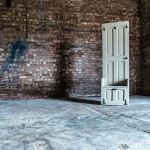Everybody’s seen them: the flats where communal areas have thriftily been omitted in favour of squeezing in another bedroom or two and increasing the rent. If bedrooms are supposed to be for sleeping, where are the people who inhabit those compact spaces supposed to do their living? This week, we’ve been thinking about one of the most efficient space-saving and multitasking bits of furniture: the wallbed.
If we take a brief journey back in time, we can see that it’s only relatively recently that bedrooms became a place for catching up on some Zs. Up until the Victorian period bedrooms were places not only to sleep, but to conduct business, socialise, give birth, do everything – we’re told – you’d do in a bathroom, to name but a few activities. (Queen Anne went so far as to commission an extremely extravagant death bed, but unfortunately died before she could put it to use.) Once those enterprising Victorians started designing houses with separate bathrooms, the bedroom started to look more like the restful space we know it to be today, and rooms started to get more task-specific.
All that said, we have been wondering here at The Box Room headquarters whether things will remain this way. In London, with house sizing becoming ever more ‘bijou’ and open plan being so popular, it doesn’t seem entirely out of the realms of possibility that the bedroom wall might come down after all. Over the years there have been a fair few bed/spacing innovations that have taken the spotlight, most notably drawer beds, bunk beds, recently the loft bed, and the oh-so-fabulous Murphy bed.
And so we come on to the man and magician himself: William Lawrence Murphy of San Francisco. Legend has it that he came up with our favourite folding bed while trying to woo an opera singer. At the time, the idea of a woman in a man’s bedroom was strictly frowned upon, so Mr. Murphy decided to take matters into his own hands and the bed out of the equation (who doesn’t love a loophole?!) He patented the pivot that folded his bed into a wall and opened a company selling them. After the San Francisco earthquake of 1906 his beds were in high demand as people rushed to fill apartments with this modern furniture and although the steel shortage around the war dealt the enterprise a blow, the Murphy bed is still very much a beloved and iconic piece of multi-tasking design.
The comic potential of the wallbed isn’t hard to fathom, and indeed, since making its film debut in 1903 in a short called Subub Surprises the Burglar (which is available to view online) it has been a consistent player in the world of film and TV, cropping up everywhere from Popeye to Family Guy, Chaplin to Bond. Sure, it’s an easy punchline, but it’s also a pretty savvy space-saving design, and in the world of high-rent, high-demand urban living, that’s priceless, right? In New York, Treehugger’s founder, Graham Hill, featured the foldaway bed in his compact living prototype as can be seen here:
Why then, given the ingenuity of the Murphy bed – or wallbed – are they not being installed in every space-challenged London abode? There are a couple of reasons, according to James Harland, the CEO at London Wallbed Company, a London-based company that have been designing and manufacturing these contraptions since the mid-1980s. The first is that, while our transatlantic cousins saw the wallbed as the answer to the question of how to create a multitasking piece of furniture, we came to a slightly different conclusion. In the UK our solution was the sofabed, which James pithily notes are comfortable neither as a bed nor a sofa, and whose ongoing domination of the dual-function furniture market must surely be attributed to the fact that those purchasing sofa beds rarely have the misfortune of having to sleep on them.
The second is simply cost. With a wallbed from somewhere like the London Wallbed Company, Clei or Furl costing in excess of £1,500, the price tag is understandably off-putting to many would-be Murphyites who probably have had a hard enough time scraping together the funds for their home in the first place. Developers are also unlikely to shell out for this innovation for the same reason: at a time when there’s so much pressure on housing costs, the additional couple of grand that having a hidden bed would add just isn’t economically viable. It’s a shame though, as the extra living that could be done in the space that your standard double bed occupies is not insubstantial: we’re basically talking about a usable area equivalent to a small room, when space around a bed is taken into account.
Price aside though, they’re still pretty nifty, and increasingly streamlined in design as well. The slimmest profile of these wallbeds can be as little as 36cm – the equivalent of a bookcase – and, as many of these designs can also rotate as well as pull down, the wall space it occupies can be made use of during those times when the bed isn’t required.
As ever there are alternatives if you’re sold on the idea but balk at the pricetag. Even a rudimentary search on somewhere like IkeaHackers reveals some pretty canny ways to make your own Murphy bed, and there are even more basic options creeping into the market as well. If you’re feeling really hands-on, there are companies such as iBedz who supply the mechanisms to hang wallbeds, so you can indulge your inner design hero, and, when you’re done constructing, can relive some of those classic comic moments yourself. Or just take a nap.
While we’d like to be able to say that you could store a whole bed in one of our sturdy boxes, we both know that wouldn’t be exactly truthful. What we can say is that here at Boxman, we can make the process of storing away the things you don’t presently have space for that bit more straightforward. We’ll deliver boxes straight to your door and return to collect them when you’re ready. Everything can be logged digitally, so you can see exactly what’s in which box - something that makes finding things that bit easier.


